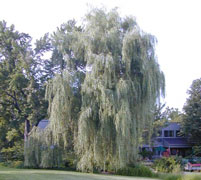


Home
Flowers &
Indoor Plants
Fruits & Nuts
Ornamentals
Vegetables
Special Topics
Resources
Glossary

|
Weeping Willow Salix alba v. tristis (say-licks al-bah)    Click on thumbnails for larger image. |
 |
| What about it? The weeping willow is a deciduous tree that grows about 60 feet tall. It has long drooping branches and an overrall rounded shape. It flowers with yellow blossoms in mid-April and the leaves will turn yellow in the fall. The twigs are also yellow. Some people are certain that these twigs become a more intense yellow as spring approaches. Others disagree. What do you think? There are several varieties of the weeping willow: Salix blanda, the Wisconsin Weeping Willow, Salix eleeantissima, the Thurlow Weeping Willow, and Salix babylonica, the Babylon Weeping Willow. There are also Black Willows and Pussy Willows.What is it used for? If you have a big lawn that is moist year-round, the willow will make a great decorative tree. They are often planted in parks and naturalistic areas near water, around ponds and lakes, or stream banks. They make wonderful shade trees. Where does it grow? How do we grow it? Willows love water. They should be planted 50 feet apart. What are its primary problems? Willows have weak wood and can be troublesome in very windy areas. They also can cause litter problems with falling leaves and branches. They are prone to cankers, and galls. For these reason, they are best planted away from buildings.
© Copyright, Department of Horticulture, Cornell University. |